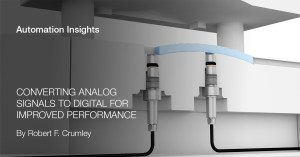It’s an understatement to say 2022 had its challenges. But looking back at the supply chain disruptions, inflation, and other trials threatening success in many industries, including manufacturing, there were practical insights we can benefit from as we dive into 2023. Below are the most popular blogs from last year’s Automation Insights site.
-
- Evolution of Pneumatic Cylinder Sensors
 Today’s pneumatic cylinders are compact, reliable, and cost-effective prime movers for automated equipment. They’re used in many industrial applications, such as machinery, material handling, assembly, robotics, and medical. One challenge facing OEMs, integrators, and end users is how to detect reliably whether the cylinder is fully extended, retracted, or positioned somewhere in between before allowing machine movement.
Today’s pneumatic cylinders are compact, reliable, and cost-effective prime movers for automated equipment. They’re used in many industrial applications, such as machinery, material handling, assembly, robotics, and medical. One challenge facing OEMs, integrators, and end users is how to detect reliably whether the cylinder is fully extended, retracted, or positioned somewhere in between before allowing machine movement.
-
- Series: Condition Monitoring & Predictive Maintenance
 By analyzing which symptoms of failure are likely to appear in the predictive domain for a given piece of equipment, you can determine which failure indicators to prioritize in your own condition monitoring and predictive maintenance discussions.
By analyzing which symptoms of failure are likely to appear in the predictive domain for a given piece of equipment, you can determine which failure indicators to prioritize in your own condition monitoring and predictive maintenance discussions.
Read the series, including the following blogs:
-
- Know Your RFID Frequency Basics
 In 2008 I purchased my first toll road RFID transponder, letting me drive through and pay my toll without stopping at a booth. This was my first real-life exposure to RFID, and it was magical. Back then, all I knew was that RFID stood for “radio frequency identification” and that it exchanged data between a transmitter and receiver using radio waves. That’s enough for a highway driver, but you’ll need more information to use RFID in an industrial automation setting. So here are some basics on what makes up an RFID system and the uses of different radio frequencies.
In 2008 I purchased my first toll road RFID transponder, letting me drive through and pay my toll without stopping at a booth. This was my first real-life exposure to RFID, and it was magical. Back then, all I knew was that RFID stood for “radio frequency identification” and that it exchanged data between a transmitter and receiver using radio waves. That’s enough for a highway driver, but you’ll need more information to use RFID in an industrial automation setting. So here are some basics on what makes up an RFID system and the uses of different radio frequencies.
-
- IO-Link Event Data: How Sensors Tell You How They’re Doing
 I have been working with IO-Link for more than 10 years, so I’ve heard lots of questions about how it works. One line of questions I hear from customers is about the operating condition of sensors. “I wish I knew when the IO-Link device loses output power,” or, “I wish my IO-Link photoelectric sensor would let me know when the lens is dirty.” The good news is that it does give you this information by sending Event Data. That’s a type of data that is usually not a focus of users, although it is available in JSON format from the REST API.
I have been working with IO-Link for more than 10 years, so I’ve heard lots of questions about how it works. One line of questions I hear from customers is about the operating condition of sensors. “I wish I knew when the IO-Link device loses output power,” or, “I wish my IO-Link photoelectric sensor would let me know when the lens is dirty.” The good news is that it does give you this information by sending Event Data. That’s a type of data that is usually not a focus of users, although it is available in JSON format from the REST API.
-
- Converting Analog Signals to Digital for Improved Performance
 We live in an analog world, where we experience temperatures, pressures, sounds, colors, etc., in seemingly infinite values. There are infinite temperature values between 70-71 degrees, for example, and an infinite number of pressure values between 50-51 psi.
We live in an analog world, where we experience temperatures, pressures, sounds, colors, etc., in seemingly infinite values. There are infinite temperature values between 70-71 degrees, for example, and an infinite number of pressure values between 50-51 psi.
We appreciate your dedication to Automation Insights in 2022 and look forward to growth and innovation in 2023.





